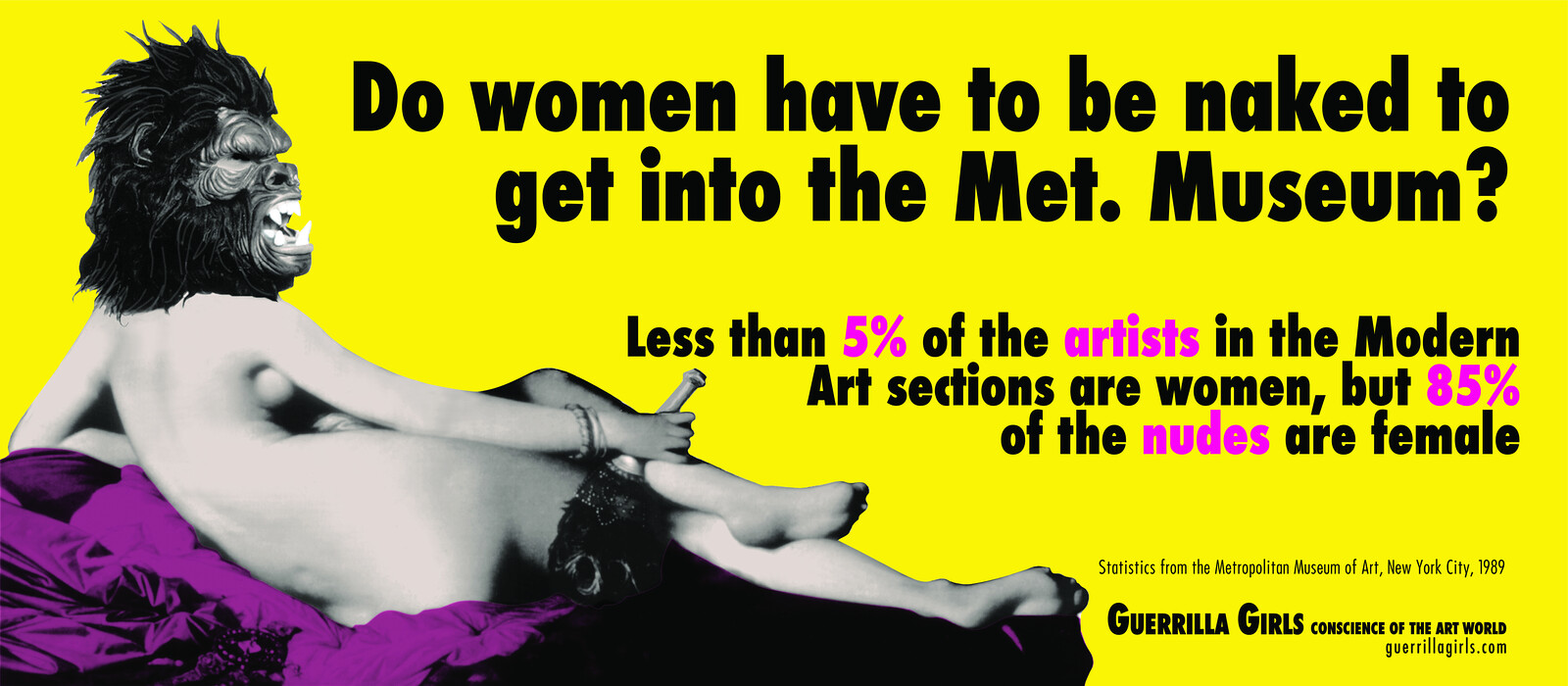The Art of Behaving Badly
January 26–April 8, 2018
Goseriede 11
30159 Hanover
Germany
Hours: Tuesday–Sunday 11am–6pm,
Thursday 11am–8pm
With the exhibition The Art of Behaving Badly by the Guerrilla Girls, the Kestner Gesellschaft is presenting one of the most important international positions of the feminist Institutional Critique. Since 1985, the Guerrilla Girls have operated as an anonymous group of female activists in the United States who draw attention to the underrepresentation of women and people of color in galleries, museums, and other art institutions. With posters in public spaces, videos, events, performances, and publications, they reveal the widespread exclusion mechanisms in the art world, which even today contribute to a one-sided, white-male-dominated art and cultural landscape. They use statistical methods, which they implement with humor and caricature-like exaggeration in various formats. The Kestner Gesellschaft is presenting the first institutional solo exhibition in Germany by the Guerrilla Girls with around thirty selected posters and banners from 1985 to today as well as four video works from 2015 and 2016. In addition, the Guerrilla Girls will present a new work, which they developed as part of their examination of the history of the Kestner Gesellschaft. The dedication of the Guerrilla Girls, who have been contributing to a critique of and sensitization to unjust hierarchy and power structures within the art system for more than thirty years, takes on a special relevance and importance with the debates surrounding #metoo and #notsurprised.
The occasion for founding the Guerrilla Girls was the exhibition An International Survey of Recent Painting and Sculpture at the Museum of Modern Art (MoMA) in New York in 1984. The exhibition curated by Kynaston McShine (1935–2018) claimed to assemble the most important positions in contemporary art at the time. Of the 165 artists in the exhibition, only thirteen were female. In protest against this significant underrepresentation of women, the Guerrilla Girls formed in 1985 as a group of artists who to this day continue to hide their true identities behind gorilla masks and the names of deceased artists such as Käthe Kollwitz, Frida Kahlo, Rosa Bonheur, and Eva Hesse. Since 1986, the Guerrilla Girls have dealt not only with feminist discourse but also with the problems of racist exclusion and prejudice regarding sexual orientation and gender identity.
The Guerrilla Girls began with their “weenie counts,” in which the number of female and male artists in the great museums and art galleries of New York were compared and made visible through poster campaigns in public places across the city. The group deliberately made use of to the political and social potential of the poster. In doing so, they brought the critique of the seemingly hermetically sealed institutional space into the public space for the first time in the 1980s and confronted these institutions with their omissions and deficits. Since then, many of the criticized institutions have adapted their collection policies to the diversity of the art world and included the Guerrilla Girls’ posters in their collections, including the Museum of Modern Art (MoMA) and the Whitney Museum of Art in New York and the Museum Ludwig in Cologne.
From 1985 to 2000, around sixty women have been involved in the Guerrilla Girls and developed numerous projects anonymously. Today, several founding members remain active in the group and develop art and exhibition projects around the world. Recently, the Guerrilla Girls took part in the Women’s March against the policies of United States President Donald Trump, and they regularly organize performances and lectures at universities, schools, and museums.
The exhibition at the Kestner Gesellschaft is supported by the Niedersächsische Sparkassenstiftung and the friends of the Kestner Gesellschaft.
Curator of the exhibition: Elmas Senol
Simultaneously on show:
Christa Dichgans
Not a Still Life
Piles of plastic toys in children’s rooms, an inflatable swimming pool animal, Batman, paper planes, and mountains of sausages are the subjects of Christa Dichgans’s (b. 1940 in Berlin) paintings. The artist is one of the most important German protagonists of Pop Art and is particularly well known for her early work from the 1960s. At the same time, Dichgans’s work is also rooted in the history of painting, such as the New Objectivity and Surrealism. With the exhibition Not a Still Life at the Kestner Gesellschaft, for the first time her work will now be the subject of a deep examination and a comprehensive institutional presentation. The exhibition will feature some seventy-five paintings created between 1963 and 2013.
The exhibition is supported by the NORD/LB Kulturstiftung and the friends of the Kestner Gesellschaft.
Curators of the exhibition: Christina Végh and Milan Ther


